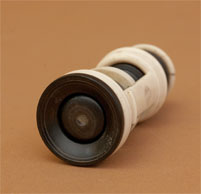 |
|||||
 |
 |
||||
 |
|||||
 |
 |
||||
Instrument No. 62 is made of bone and a dark wood (probably Lignum vitae), and consists of only a few components. The central screw barrel is the condenser assembly, which had no lens or is now missing the original condenser lens. It is screwed into the turned bone barrel. The barrel has a large square cutout to accommodate the two flat bone sample holders, coiled brass spring, and the objective assembly. The sample, a folding animalcule cage or a glass phial, would be placed between the two flat holders. Focusing was accomplished by screwing in or out the condenser assembly, which would press the sample nearer or further to the magnifying lens. The objective consists of a biconvex lens mounted in a hardwood. This instrument has only one objective lens that sits in the base of the body and is removed easily. Wilson-type instruments came with six lenses that screw into the body, thus it is possible that this instrument also came with additional interchangeable lens assemblies. Imaging is good but shows considerable vignetting.
Featured 04/2011

